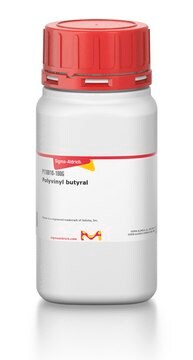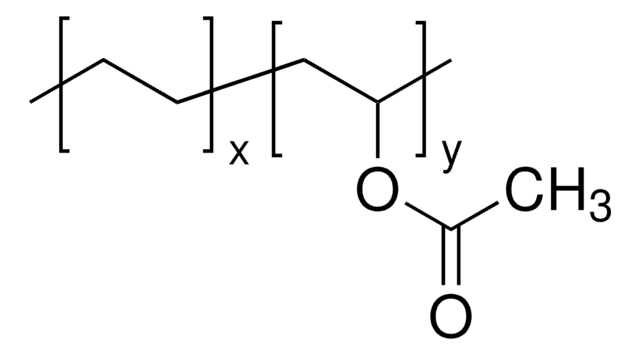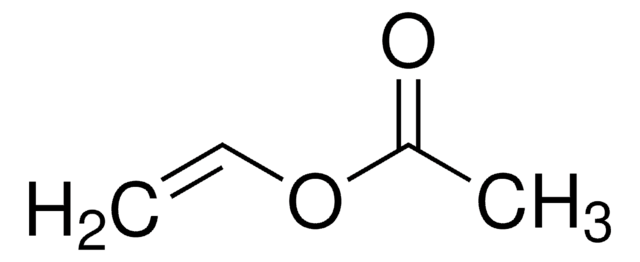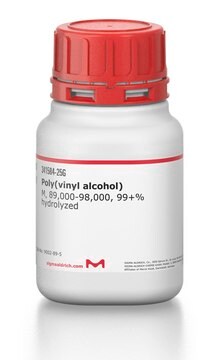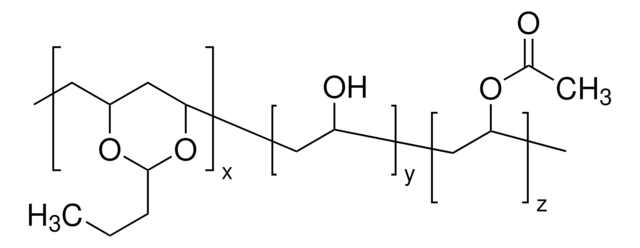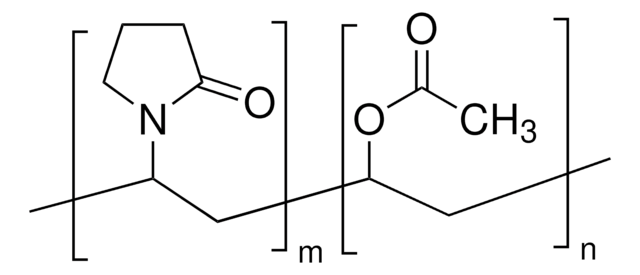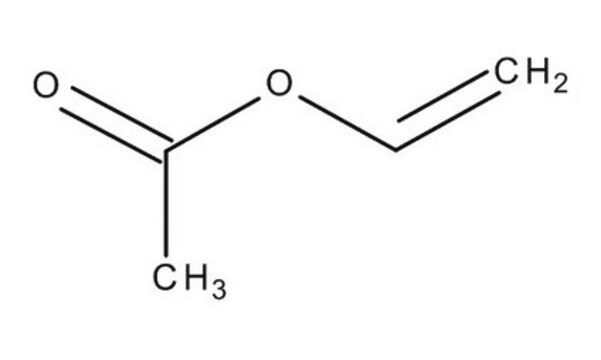Alle Fotos(3)
Wichtige Dokumente
189480
Poly(vinylacetat)
average Mw ~100,000 by GPC, beads
Synonym(e):
Polyvinylacetat
Anmeldenzur Ansicht organisationsspezifischer und vertraglich vereinbarter Preise
Alle Fotos(3)
About This Item
Lineare Formel:
[CH2CH(O2CCH3)]n
CAS-Nummer:
MDL-Nummer:
UNSPSC-Code:
12162002
PubChem Substanz-ID:
NACRES:
NA.23
Empfohlene Produkte
Form
beads
Mol-Gew.
average Mw ~100,000 by GPC
Viskosität
17-21 sec.(25 °C, Ford, no. 4)(lit.)
Dichte
1.18 g/mL at 25 °C
Lagertemp.
2-8°C
SMILES String
COC(=O)C=C
InChI
1S/C4H6O2/c1-3-6-4(2)5/h3H,1H2,2H3
InChIKey
XTXRWKRVRITETP-UHFFFAOYSA-N
Suchen Sie nach ähnlichen Produkten? Aufrufen Leitfaden zum Produktvergleich
Allgemeine Beschreibung
Poly(vinylacetat) (PVAc) ist ein nichtkristallines, ataktisches Polymer. Es wird aus Vinylacetatmonomerdurch eine freie Radikalpolymerisation hergestellt. Es wird verbreitetin der Lebensmittelindustrie eingesetzt, da es eine geringe Toxizität und ausgezeichnete Flexibilität besitzt. PVAc-Filme werden als Emissionssensoren fürFahrzeuge und in oralen Arzneimittelabgabeprodukten verwendet.
Anwendung
Poly(vinylacetat) kann als Folgendes verwendet werden:
- Ausgangsmaterial zum Herstellen von Polymerfasern für Gas- und Feuchtigkeitssensoranwendungen. Citronensäure-dotierte PVAc-Nanofasermatten können zum Entwickeln von Sensoren für Trimethylamingas bei Raumtemperatur eingesetzt werden.
- Polymerbeschichtung für schwimmende Tabletten mit einer kontrollierten Arzneimittelabgabe. PVAc eignet sich als Arzneiträgerstoff für eine zuverlässige und sichere Arzneimittelabgabe. PVAc-basierte Matrixtabletten fließen aufgrund ihrer intrinsisch geringen Dichte und hohen Elastizität der Polyvinylacetatbeschichtung.
Lagerklassenschlüssel
11 - Combustible Solids
WGK
nwg
Flammpunkt (°F)
Not applicable
Flammpunkt (°C)
Not applicable
Persönliche Schutzausrüstung
Eyeshields, Gloves, type N95 (US)
Hier finden Sie alle aktuellen Versionen:
Besitzen Sie dieses Produkt bereits?
In der Dokumentenbibliothek finden Sie die Dokumentation zu den Produkten, die Sie kürzlich erworben haben.
Kunden haben sich ebenfalls angesehen
K Kolter et al.
International journal of pharmaceutics, 457(2), 470-479 (2013-10-01)
Polyvinyl acetate-based colloidal aqueous polymer dispersion Kollicoat(®) SR 30 D results in coatings characterized by moderate swelling behaviour, lipophilicity, pH-independent permeability for actives and high flexibility to withstand mechanical stress and is therefore used for controlled release coating. The colloidal
Cellulose nanofibrils/polyvinyl acetate nanocomposite adhesives with improved mechanical properties.
Ons Chaabouni et al.
Carbohydrate polymers, 156, 64-70 (2016-11-16)
Cellulose nanofibrils (CNFs) are nanoscale cellulose produced from renewable resources with strong reinforcing potential when included in a polymer matrix. In this work, the effect of the addition of CNFs on the properties of waterborne polyvinylacetate (PVA) adhesive was investigated.
Il Gyu Kang et al.
American journal of rhinology & allergy, 24(5), 392-395 (2011-01-20)
The aim of this study was to evaluate the effect of repeated expandable polyvinyl acetate (EPA) packing for preventing stenosis of the frontal sinus ostium after patients undergo functional endoscopic sinus surgery (FESS). A nonrandomized, prospective study of 20 patients
Dong-Hao Zhang et al.
Bioresource technology, 124, 233-236 (2012-09-20)
Poly(vinyl acetate-acrylamide) microspheres were synthesized in the absence or presence of isooctane via suspension polymerization and utilized as carriers to immobilize Candida rugosa lipase. When the hydrophobic/hydrophilic surface characteristics of the microspheres were modified by changing the ratio of vinyl
Ehab A Fouad et al.
Expert opinion on drug delivery, 8(5), 693-703 (2011-03-23)
Developments in industrial pharmacy are often linked to the discovery of pharmaceutical excipients. Although recently introduced as a material for immediate release coatings, Kollicoat IR already has other applications. In this review, the different properties and pharmaceutical applications of Kollicoat
Unser Team von Wissenschaftlern verfügt über Erfahrung in allen Forschungsbereichen einschließlich Life Science, Materialwissenschaften, chemischer Synthese, Chromatographie, Analytik und vielen mehr..
Setzen Sie sich mit dem technischen Dienst in Verbindung.
